#red lily indoor plant
Explore tagged Tumblr posts
Text
i think i have given up on the yard now
there are things planted and we'll see what we'll see, but from everything i've read stuff will either die in the 110F heat or later on in a winter freeze so further $ invested may be a waste
and the only solution is to keep everything as potted-and-mobile or indoor plants
there's already been issues with ants and gnats so the impetus to leave them outside and then bring them in later is now very low
so maybe i will just have a lot of indoor plants - at least i can take them with me when i go
the one pothos is at least VERY enthusiastic and all the greenery is *so* fucking mentally soothing
... i just really want to buy so many more plants and i *have* to stop
#maybe if i liked succulents more or cared about flowers#but what i like is green and leafy and e idently none of that is really happy around here#like i have 'almost total shade' and 'lots of sun' options but nothing that will take those PLUS the stupid heat even with watering#gonna plant the the asiatic jasmine anyway just to see but then i guess just try to keep up with watering#i have two sansevieria a boston fern several pothos two peace lilies (one 3 ft) salvia sage oregano#a very sad dieffenbachia and tiny croton and some rosemary that i think gave up the ghost while the mint *may* be hanging on#got some indoor elephant ears from a kit just starting we'll see what happens and a red anne#the hostas and caladiums will come up or not idk#i just wish i knew something that would grow like these weeds lol thank goodness for the horseherb#i realized that sll i want is the same plants we had growing up but we were in sub-sealevel galveston - basically tropical#so all that won't necessarily like it here - people say hostas don't like austin :/#but we had what i'm pretty sure was the asiatic jasmine out at the front of the house and the elephantears and caladium#around the side with the ivy and the dracaena and the azaleas#everything i see that i like in the nursery ends up being labeled 'indoor plant' here#tempted to try to find some pink mulhy even though it's not 'leafy' just bc it grows here and might live#the palmetto does keep coming back after the freezes so that's something#obviously if i wanted to spend a lot my problems would be easily solved but it's not my house so i'm not buying like .. full shrubs
8 notes
·
View notes
Text
Anthurium
Anthurium

Anthurium flower plant is most famous in floral world. Anthurium andraeanum characteristic feature is an indoor ornamental plant with bright coloured spathe leaf. It can be propagated through seed, cuttings and tissue culture method.
Types
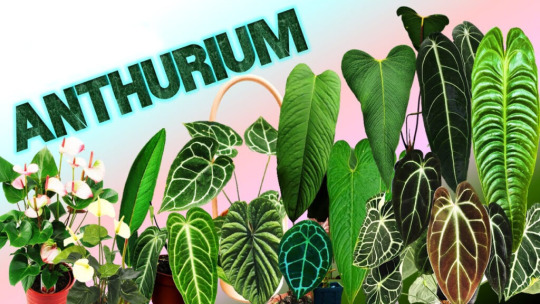
Anthuriums flower has more 1000 species depending upon their foliage leaves. There are tropical anthuriums, anthuriums passion pink, anthuriums chocolate, flame red, Mauritius white and sunshine orange.

Red anthuriums flowers symbolize hospitality. It's referred as Flamingo Lily or painters palette. Tropical anthurium possesses attractive long-lasting inflorescence. Spadix is too short.
Anthurium passion pink
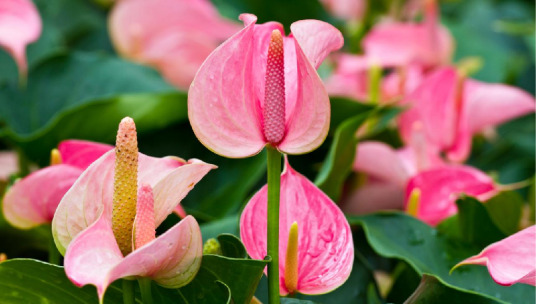
The pink colour plant is commonly referred to as an oilcloth flower and laceleaf. The pink colour flower calyx is too shiny to touch. Anthurium passion pink is a cut flower, potted flowering, foliage plant and an ornamental plant. Passion is a semi-terrestrial herbaceous plant. Pink flower leaves are long, tender, shiny and heart-shaped leaves.
Anthurium chocolate
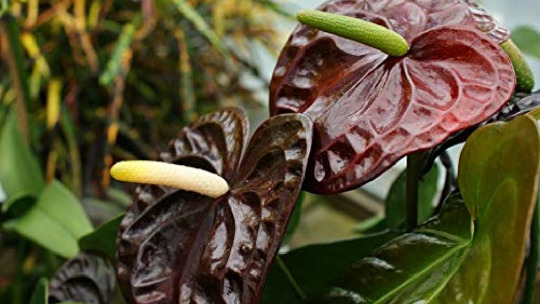
This Anthuriums is a monocotyledonous plant. Air-purifying plant nasa blooms arise from the leaf axil and produce flowers on each leaf which are too attractive. Anthurium chocolate flower leaves are long, Passion requires low temperatures and is popular as a pot plant. This plant is the ornamental shade plant and flower plant.
Anthurium flame red
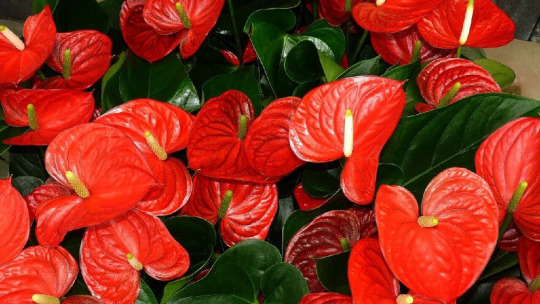
It has a gorgeous look for its lovely blooming. Keeping Anthurium flame red fully indoors may not produce flowers, bright light is important to produce flowering. These look like shiny dark green and heart-shaped leaves.
Anthurium Mauritius white
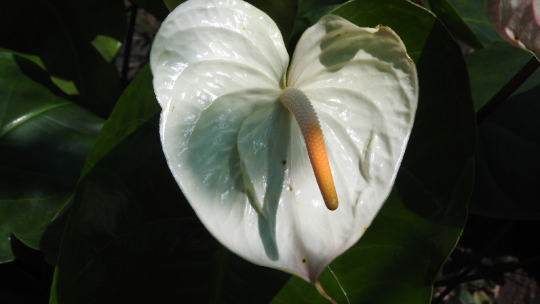
This anthuriums plant gets its name as its little spirit of nature. Anthurium Mauritius white flowers blooms all year round. Its splendid appearance can reduce human stress. This anthuriums flower is a rare species. Anthuriums flower plants are harvested a week. White petals resemble peace and positivity. Spathe has a gorgeous look.
Anthurium sunshine orange

Anthuriums andraeanum plant is a NASA air purifier plant. Even every leaf carries flowers which are a sunshine orange colour. Anthurium sunshine orange is an evergreen tropical shrub flower. This flower is mainly used as focal arrangement for its colourful spathe. This is one of the best vastu plants.
Soil
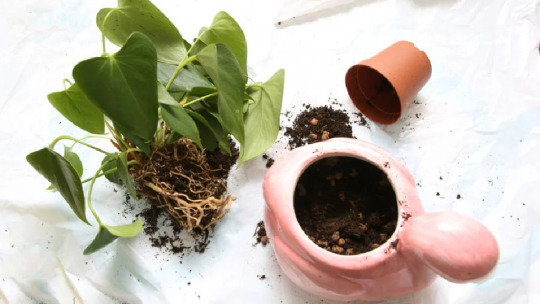
Love to grow in well-drained soil which can prevent the rotting of roots and stem. Anthurium andraeanum has an epiphytic aerial roots system. Anthuriums flamingo flower well grown in coconut husk.
Watering
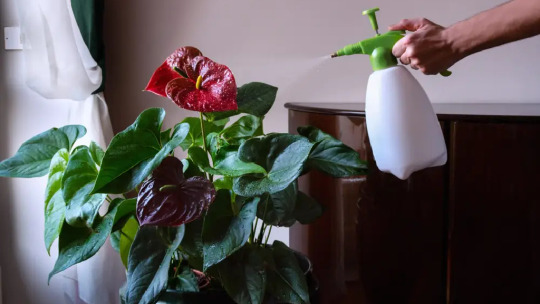
Anthuriums requires regular watering. This is a moisture-loving plant. Flamingo flower fleshy roots absorb huge water. Prompt watering enhances shoot growth. Watered in the early morning. Maintain relative humidity ranges between 70-80%.
Sunlight

If planted as an indoor plant the pots placed near window sides (southwest direction) to getting best sunlight. If a garden plants needs bright light but not exposure to direct sunlight. Bright light enhances the bright colour spathe, velvety leaves.
Fertilizer

Application of well-decomposed organic manure at two months intervals. Flamingo flower soil mixed with manure, coco peat, and dried leaves. Add banana peels contain phosphorous, iron and calcium.
Repotting
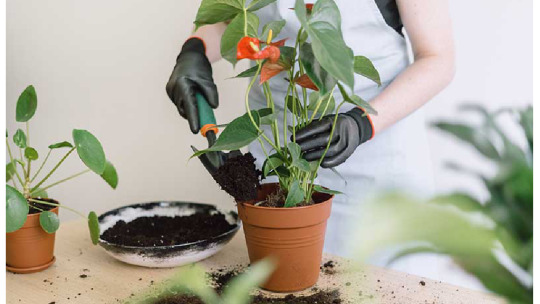
Repot the anthuriums plant at one year intervals. After six months the plant is ready for transplanting. At the time of repotting gently remove the plant from pots without damaging the root parts.
Pruning
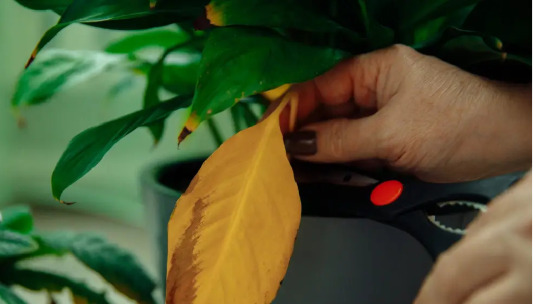
Prune the dried and old leaves. Remove the dried or mature flowers. Avoid over prune the plant.
Benefits
Best air purifier plants proved by NASA. Makes the environment with positivity. This plant reduces human stress. Its leaves clean the air from formaldehyde and xylene. This plant produces oxygen. Easy to propagate by tissue culture methods.
“Go green or we all will scream” Anthurium andraeanum air-purifier plant Blog created by: Santhionlineplants
#anthurium#Anthurium flower plant is most famous in floral world. Anthurium andraeanum characteristic feature is an indoor ornamental plant with brigh#cuttings and tissue culture method.#Types#varieties#Anthuriums flower has more 1000 species depending upon their foliage leaves. There are tropical anthuriums#anthuriums passion pink#anthuriums chocolate#flame red#Mauritius white and sunshine orange.#Tropical anthurium#Red anthuriums flowers symbolize hospitality. It's referred as Flamingo Lily or painters palette. Tropical anthurium possesses attractive l#Anthurium passion pink#anthurium passion pink#The pink colour plant is commonly referred to as an oilcloth flower and laceleaf. The pink colour flower calyx is too shiny to touch. Anthu#potted flowering#foliage plant and an ornamental plant. Passion is a semi-terrestrial herbaceous plant. Pink flower leaves are long#tender#shiny and heart-shaped leaves.#Anthurium chocolate#anthurium chocolate#This Anthuriums is a monocotyledonous plant. Air-purifying plant nasa blooms arise from the leaf axil and produce flowers on each leaf whic#Passion requires low temperatures and is popular as a pot plant. This plant is the ornamental shade plant and flower plant.#Anthurium flame red#anthurium flame red#It has a gorgeous look for its lovely blooming. Keeping Anthurium flame red fully indoors may not produce flowers#bright light is important to produce flowering. These look like shiny dark green and heart-shaped leaves.#Anthurium Mauritius white#anthurium mauritius white#This anthuriums plant gets its name as its little spirit of nature. Anthurium Mauritius white flowers blooms all year round. Its splendid a
0 notes
Text
Anthurium
Anthurium
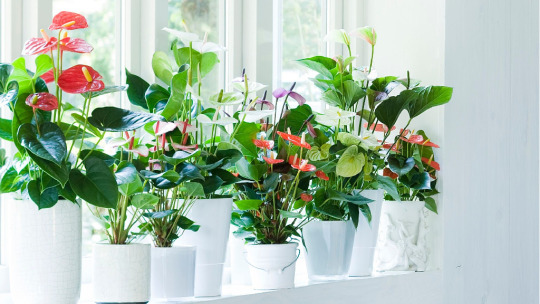
Anthurium flower plant is most famous in floral world. Anthurium andraeanum characteristic feature is an indoor ornamental plant with bright coloured spathe leaf. It can be propagated through seed, cuttings and tissue culture method.
Types

Anthuriums flower has more 1000 species depending upon their foliage leaves. There are tropical anthuriums, anthuriums passion pink, anthuriums chocolate, flame red, Mauritius white and sunshine orange.
Tropical anthurium

Red anthuriums flowers symbolize hospitality. It's referred as Flamingo Lily or painters palette. Tropical anthurium possesses attractive long-lasting inflorescence. Spadix is too short.
Anthurium passion pink
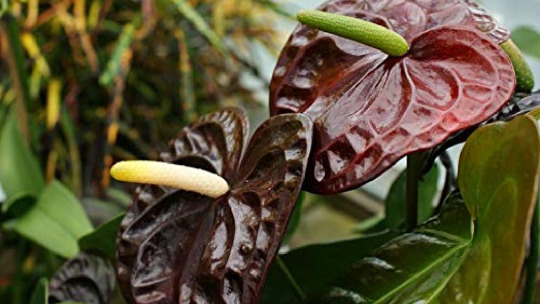
The pink colour plant is commonly referred to as an oilcloth flower and laceleaf. The pink colour flower calyx is too shiny to touch. Anthurium passion pink is a cut flower, potted flowering, foliage plant and an ornamental plant. Passion is a semi-terrestrial herbaceous plant. Pink flower leaves are long, tender, shiny and heart-shaped leaves.
Anthurium chocolate
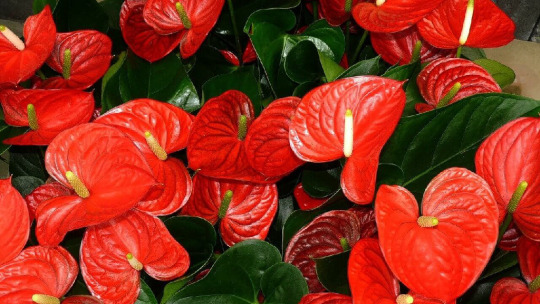
This Anthuriums is a monocotyledonous plant. Air-purifying plant nasa blooms arise from the leaf axil and produce flowers on each leaf which are too attractive. Anthurium chocolate flower leaves are long, Passion requires low temperatures and is popular as a pot plant. This plant is the ornamental shade plant and flower plant.
Anthurium flame red
It has a gorgeous look for its lovely blooming. Keeping Anthurium flame red fully indoors may not produce flowers, bright light is important to produce flowering. These look like shiny dark green and heart-shaped leaves.
Anthurium Mauritius white
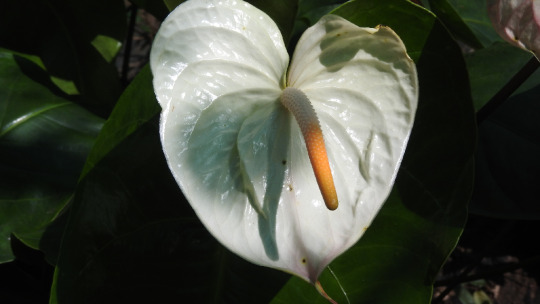
This anthuriums plant gets its name as its little spirit of nature. Anthurium Mauritius white flowers blooms all year round. Its splendid appearance can reduce human stress. This anthuriums flower is a rare species. Anthuriums flower plants are harvested a week. White petals resemble peace and positivity. Spathe has a gorgeous look.
Anthurium sunshine orange
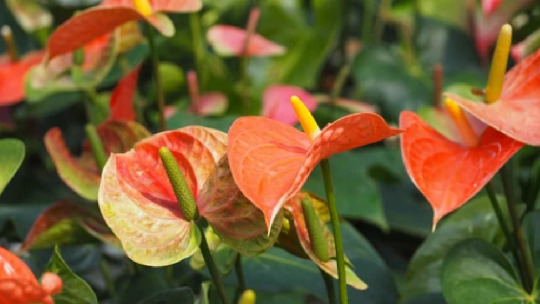
Anthuriums andraeanum plant is a NASA air purifier plant. Even every leaf carries flowers which are a sunshine orange colour. Anthurium sunshine orange is an evergreen tropical shrub flower. This flower is mainly used as focal arrangement for its colourful spathe. This is one of the best vastu plants.
Soil
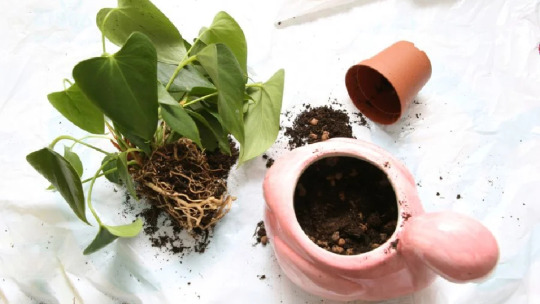
Love to grow in well-drained soil which can prevent the rotting of roots and stem. Anthurium andraeanum has an epiphytic aerial roots system. Anthuriums flamingo flower well grown in coconut husk.
Watering
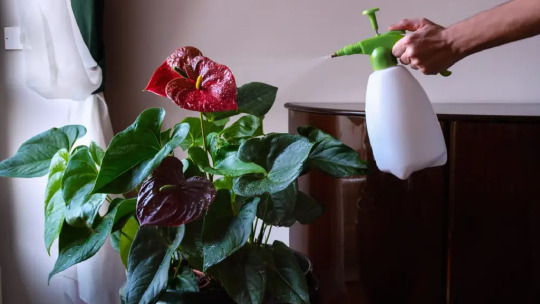
Anthuriums requires regular watering. This is a moisture-loving plant. Flamingo flower fleshy roots absorb huge water. Prompt watering enhances shoot growth. Watered in the early morning. Maintain relative humidity ranges between 70-80%.
Sunlight
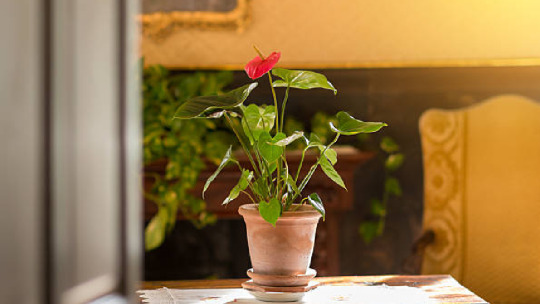
If planted as an indoor plant the pots placed near window sides (southwest direction) to getting best sunlight. If a garden plants needs bright light but not exposure to direct sunlight. Bright light enhances the bright colour spathe, velvety leaves.
Fertilizer
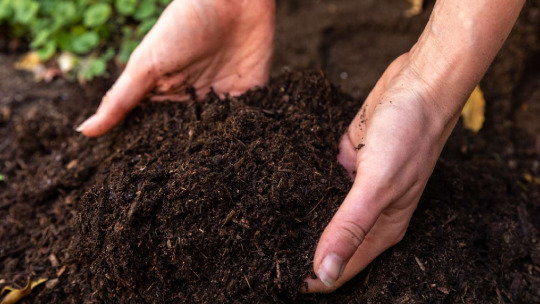
Application of well-decomposed organic manure at two months intervals. Flamingo flower soil mixed with manure, coco peat, and dried leaves. Add banana peels contain phosphorous, iron and calcium.
Repotting
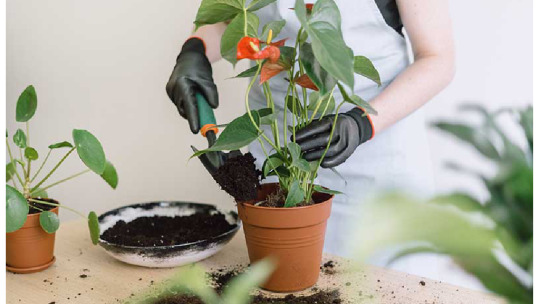
Repot the anthuriums plant at one year intervals. After six months the plant is ready for transplanting. At the time of repotting gently remove the plant from pots without damaging the root parts.
Pruning
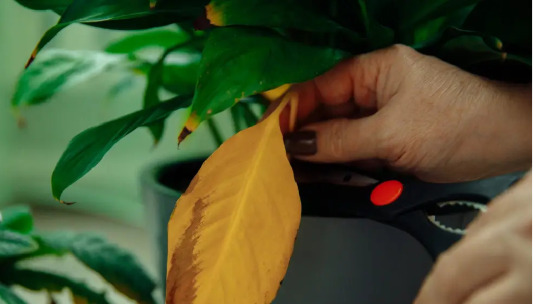
Prune the dried and old leaves. Remove the dried or mature flowers. Avoid over prune the plant.
Benefits
Best air purifier plants proved by NASA. Makes the environment with positivity. This plant reduces human stress. Its leaves clean the air from formaldehyde and xylene. This plant produces oxygen. Easy to propagate by tissue culture methods.
“Go green or we all will scream”
#Anthurium#Anthurium flower plant is most famous in floral world. Anthurium andraeanum characteristic feature is an indoor ornamental plant with brigh#cuttings and tissue culture method.#Types#Anthuriums flower has more 1000 species depending upon their foliage leaves. There are tropical anthuriums#anthuriums passion pink#anthuriums chocolate#flame red#Mauritius white and sunshine orange.#Tropical anthurium#Red anthuriums flowers symbolize hospitality. It's referred as Flamingo Lily or painters palette. Tropical anthurium possesses attractive l#Anthurium passion pink#The pink colour plant is commonly referred to as an oilcloth flower and laceleaf. The pink colour flower calyx is too shiny to touch. Anthu#potted flowering#foliage plant and an ornamental plant. Passion is a semi-terrestrial herbaceous plant. Pink flower leaves are long#tender#shiny and heart-shaped leaves.#Anthurium chocolate#This Anthuriums is a monocotyledonous plant. Air-purifying plant nasa blooms arise from the leaf axil and produce flowers on each leaf whic#Passion requires low temperatures and is popular as a pot plant. This plant is the ornamental shade plant and flower plant.#Anthurium flame red#It has a gorgeous look for its lovely blooming. Keeping Anthurium flame red fully indoors may not produce flowers#bright light is important to produce flowering. These look like shiny dark green and heart-shaped leaves.#Anthurium Mauritius white#This anthuriums plant gets its name as its little spirit of nature. Anthurium Mauritius white flowers blooms all year round. Its splendid a#Anthurium sunshine orange#Anthuriums andraeanum plant is a NASA air purifier plant. Even every leaf carries flowers which are a sunshine orange colour. Anthurium sun#Soil#Love to grow in well-drained soil which can prevent the rotting of roots and stem. Anthurium andraeanum has an epiphytic aerial roots syste#Watering
0 notes
Text
Anthurium
Anthurium
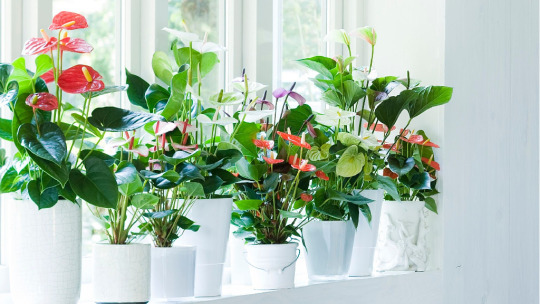
Anthurium flower plant is most famous in floral world. Anthurium andraeanum characteristic feature is an indoor ornamental plant with bright coloured spathe leaf. It can be propagated through seed, cuttings and tissue culture method.
Types

Anthuriums flower has more 1000 species depending upon their foliage leaves. There are tropical anthuriums, anthuriums passion pink, anthuriums chocolate, flame red, Mauritius white and sunshine orange.
Tropical anthurium
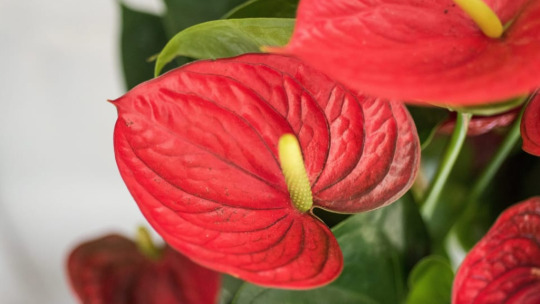
Red anthuriums flowers symbolize hospitality. It's referred as Flamingo Lily or painters palette. Tropical anthurium possesses attractive long-lasting inflorescence. Spadix is too short.
Anthurium passion pink
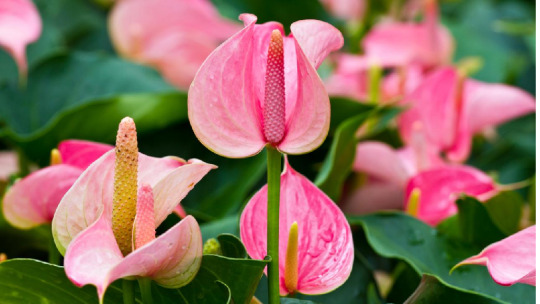
The pink colour plant is commonly referred to as an oilcloth flower and laceleaf. The pink colour flower calyx is too shiny to touch. Anthurium passion pink is a cut flower, potted flowering, foliage plant and an ornamental plant. Passion is a semi-terrestrial herbaceous plant. Pink flower leaves are long, tender, shiny and heart-shaped leaves.
Anthurium chocolate
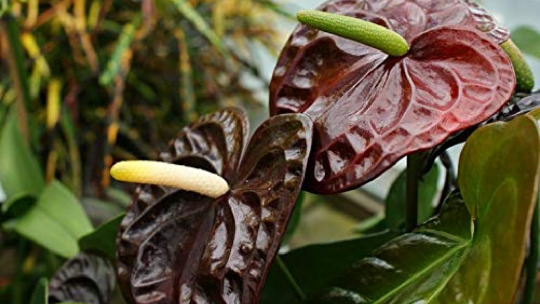
This Anthuriums is a monocotyledonous plant. Air-purifying plant nasa blooms arise from the leaf axil and produce flowers on each leaf which are too attractive. Anthurium chocolate flower leaves are long, Passion requires low temperatures and is popular as a pot plant. This plant is the ornamental shade plant and flower plant.
Anthurium flame red
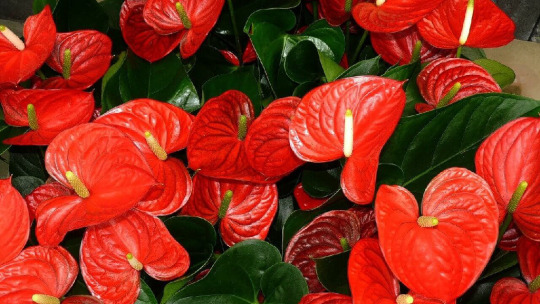
It has a gorgeous look for its lovely blooming. Keeping Anthurium flame red fully indoors may not produce flowers, bright light is important to produce flowering. These look like shiny dark green and heart-shaped leaves.
Anthurium Mauritius white

This anthuriums plant gets its name as its little spirit of nature. Anthurium Mauritius white flowers blooms all year round. Its splendid appearance can reduce human stress. This anthuriums flower is a rare species. Anthuriums flower plants are harvested a week. White petals resemble peace and positivity. Spathe has a gorgeous look.
Anthurium sunshine orange

Anthuriums andraeanum plant is a NASA air purifier plant. Even every leaf carries flowers which are a sunshine orange colour. Anthurium sunshine orange is an evergreen tropical shrub flower. This flower is mainly used as focal arrangement for its colourful spathe. This is one of the best vastu plants.
Soil
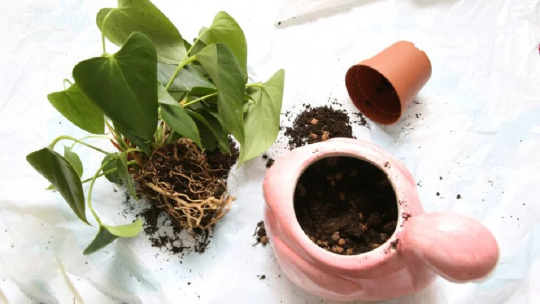
Love to grow in well-drained soil which can prevent the rotting of roots and stem. Anthurium andraeanum has an epiphytic aerial roots system. Anthuriums flamingo flower well grown in coconut husk.
Watering

Anthuriums requires regular watering. This is a moisture-loving plant. Flamingo flower fleshy roots absorb huge water. Prompt watering enhances shoot growth. Watered in the early morning. Maintain relative humidity ranges between 70-80%.
Sunlight

If planted as an indoor plant the pots placed near window sides (southwest direction) to getting best sunlight. If a garden plants needs bright light but not exposure to direct sunlight. Bright light enhances the bright colour spathe, velvety leaves.
Fertilizer
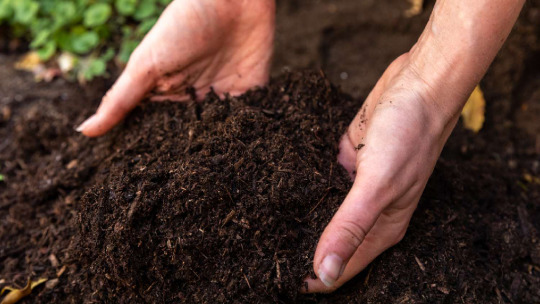
Application of well-decomposed organic manure at two months intervals. Flamingo flower soil mixed with manure, coco peat, and dried leaves. Add banana peels contain phosphorous, iron and calcium.
Repotting

Repot the anthuriums plant at one year intervals. After six months the plant is ready for transplanting. At the time of repotting gently remove the plant from pots without damaging the root parts.
Pruning

Prune the dried and old leaves. Remove the dried or mature flowers. Avoid over prune the plant.
Benefits
Best air purifier plants proved by NASA. Makes the environment with positivity. This plant reduces human stress. Its leaves clean the air from formaldehyde and xylene. This plant produces oxygen. Easy to propagate by tissue culture methods.
“Go green or we all will scream” Anthurium andraeanum air-purifier plant Blog created by: Santhionlineplants
#Anthurium#anthurium#Anthurium flower plant is most famous in floral world. Anthurium andraeanum characteristic feature is an indoor ornamental plant with brigh#cuttings and tissue culture method.#Types#varieties#Anthuriums flower has more 1000 species depending upon their foliage leaves. There are tropical anthuriums#anthuriums passion pink#anthuriums chocolate#flame red#Mauritius white and sunshine orange.#Tropical anthurium#Red anthuriums flowers symbolize hospitality. It's referred as Flamingo Lily or painters palette. Tropical anthurium possesses attractive l#Anthurium passion pink#anthurium passion pink#The pink colour plant is commonly referred to as an oilcloth flower and laceleaf. The pink colour flower calyx is too shiny to touch. Anthu#potted flowering#foliage plant and an ornamental plant. Passion is a semi-terrestrial herbaceous plant. Pink flower leaves are long#tender#shiny and heart-shaped leaves.#Anthurium chocolate#anthurium chocolate#This Anthuriums is a monocotyledonous plant. Air-purifying plant nasa blooms arise from the leaf axil and produce flowers on each leaf whic#Passion requires low temperatures and is popular as a pot plant. This plant is the ornamental shade plant and flower plant.#Anthurium flame red#anthurium flame red#It has a gorgeous look for its lovely blooming. Keeping Anthurium flame red fully indoors may not produce flowers#bright light is important to produce flowering. These look like shiny dark green and heart-shaped leaves.#Anthurium Mauritius white#anthurium mauritius white
0 notes
Text
Anthurium
Anthurium
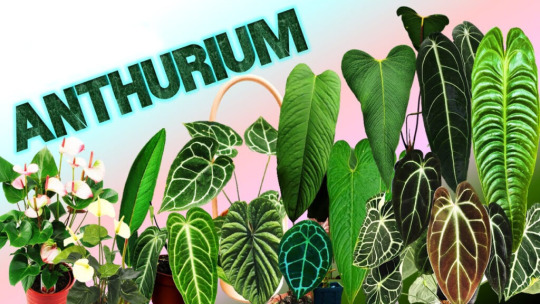
Anthurium flower plant is most famous in floral world. Anthurium andraeanum characteristic feature is an indoor ornamental plant with bright coloured spathe leaf. It can be propagated through seed, cuttings and tissue culture method.
Types

Anthuriums flower has more 1000 species depending upon their foliage leaves. There are tropical anthuriums, anthuriums passion pink, anthuriums chocolate, flame red, Mauritius white and sunshine orange.
Tropical anthurium

Red anthuriums flowers symbolize hospitality. It's referred as Flamingo Lily or painters palette. Tropical anthurium possesses attractive long-lasting inflorescence. Spadix is too short.
Anthurium passion pink
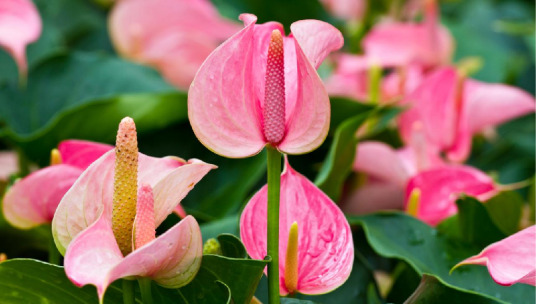
The pink colour plant is commonly referred to as an oilcloth flower and laceleaf. The pink colour flower calyx is too shiny to touch. Anthurium passion pink is a cut flower, potted flowering, foliage plant and an ornamental plant. Passion is a semi-terrestrial herbaceous plant. Pink flower leaves are long, tender, shiny and heart-shaped leaves.
Anthurium chocolate
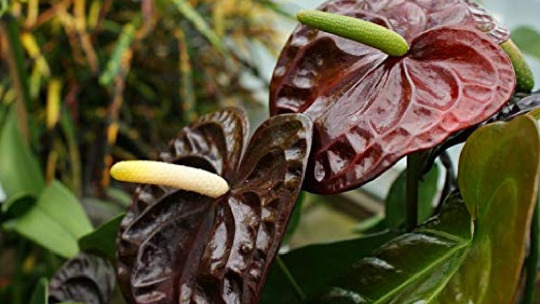
This Anthuriums is a monocotyledonous plant. Air-purifying plant nasa blooms arise from the leaf axil and produce flowers on each leaf which are too attractive. Anthurium chocolate flower leaves are long, Passion requires low temperatures and is popular as a pot plant. This plant is the ornamental shade plant and flower plant.
Anthurium flame red
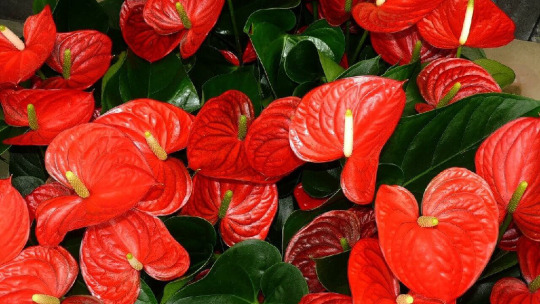
It has a gorgeous look for its lovely blooming. Keeping Anthurium flame red fully indoors may not produce flowers, bright light is important to produce flowering. These look like shiny dark green and heart-shaped leaves.
Anthurium Mauritius white

This anthuriums plant gets its name as its little spirit of nature. Anthurium Mauritius white flowers blooms all year round. Its splendid appearance can reduce human stress. This anthuriums flower is a rare species. Anthuriums flower plants are harvested a week. White petals resemble peace and positivity. Spathe has a gorgeous look.
Anthurium sunshine orange
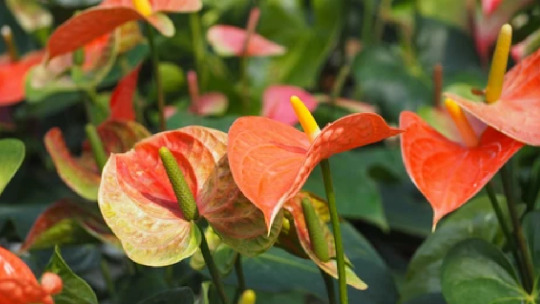
Anthuriums andraeanum plant is a NASA air purifier plant. Even every leaf carries flowers which are a sunshine orange colour. Anthurium sunshine orange is an evergreen tropical shrub flower. This flower is mainly used as focal arrangement for its colourful spathe. This is one of the best vastu plants.
Soil
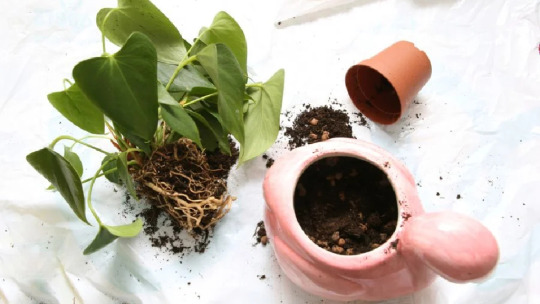
Love to grow in well-drained soil which can prevent the rotting of roots and stem. Anthurium andraeanum has an epiphytic aerial roots system. Anthuriums flamingo flower well grown in coconut husk.
Watering

Anthuriums requires regular watering. This is a moisture-loving plant. Flamingo flower fleshy roots absorb huge water. Prompt watering enhances shoot growth. Watered in the early morning. Maintain relative humidity ranges between 70-80%.
Sunlight
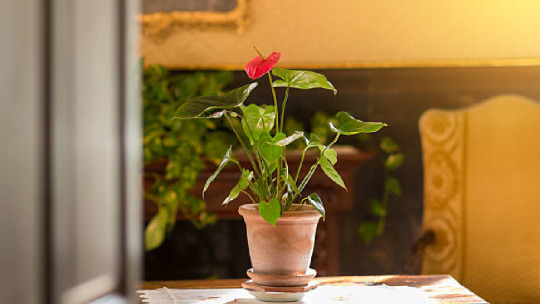
If planted as an indoor plant the pots placed near window sides (southwest direction) to getting best sunlight. If a garden plants needs bright light but not exposure to direct sunlight. Bright light enhances the bright colour spathe, velvety leaves.
Fertilizer
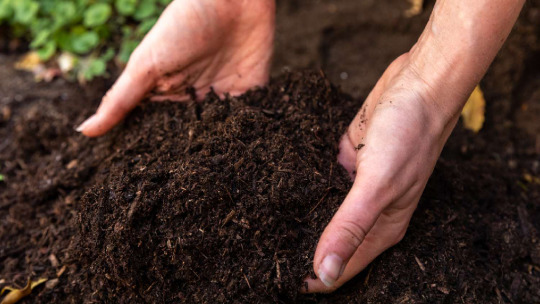
Application of well-decomposed organic manure at two months intervals. Flamingo flower soil mixed with manure, coco peat, and dried leaves. Add banana peels contain phosphorous, iron and calcium.
Repotting
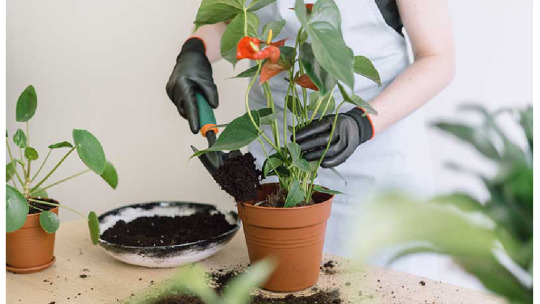
Repot the anthuriums plant at one year intervals. After six months the plant is ready for transplanting. At the time of repotting gently remove the plant from pots without damaging the root parts.
Pruning

Prune the dried and old leaves. Remove the dried or mature flowers. Avoid over prune the plant.
Benefits
Best air purifier plants proved by NASA. Makes the environment with positivity. This plant reduces human stress. Its leaves clean the air from formaldehyde and xylene. This plant produces oxygen. Easy to propagate by tissue culture methods.
“Go green or we all will scream” Anthurium andraeanum air-purifier plant Blog created by: Santhionlineplants
Ramajayam
#Anthurium#anthurium#Anthurium flower plant is most famous in floral world. Anthurium andraeanum characteristic feature is an indoor ornamental plant with brigh#cuttings and tissue culture method.#Types#varieties#Anthuriums flower has more 1000 species depending upon their foliage leaves. There are tropical anthuriums#anthuriums passion pink#anthuriums chocolate#flame red#Mauritius white and sunshine orange.#Tropical anthurium#Red anthuriums flowers symbolize hospitality. It's referred as Flamingo Lily or painters palette. Tropical anthurium possesses attractive l#Anthurium passion pink#anthurium passion pink#The pink colour plant is commonly referred to as an oilcloth flower and laceleaf. The pink colour flower calyx is too shiny to touch. Anthu#potted flowering#foliage plant and an ornamental plant. Passion is a semi-terrestrial herbaceous plant. Pink flower leaves are long#tender#shiny and heart-shaped leaves.#Anthurium chocolate#anthurium chocolate#This Anthuriums is a monocotyledonous plant. Air-purifying plant nasa blooms arise from the leaf axil and produce flowers on each leaf whic#Passion requires low temperatures and is popular as a pot plant. This plant is the ornamental shade plant and flower plant.#Anthurium flame red#anthurium flame red#It has a gorgeous look for its lovely blooming. Keeping Anthurium flame red fully indoors may not produce flowers#bright light is important to produce flowering. These look like shiny dark green and heart-shaped leaves.#Anthurium Mauritius white#anthurium mauritius white
0 notes
Text
𖥻 THINGS — enhypen ◌ ִ ۫ ּ
syn ; things enha reminds me of !




heeseung !
dangly earrings, pendent chains, skinny ripped jeans, rock guitar, clubbing, late studio night, concerts, rainy empty street, love songs, specs, ice cream, deers, rainforest, going over the speed limit, long drive, polaroids, balcony, tattoos, collage campus, basketball, getting into fist fights, breaking rules, warm breeze, kisses, sharing earphones, untied shoelaces, sleeveless tops, cross jewelries, chase atlantic songs
jay !
red wine, ball dance, guitar, empty kitchen, champagne bubbles, tuxedo suits, runaway, black cat, fashion magazines, gold jewelries, camping, eucalyptus, biking, biker jackets, street racing, late night walks, city lights, porsche, cologne, the weeknd songs, loose tie, fancy restaurant, chanel bags, iced americano, home, long hugs, words of affirmation, eye contact, autumn, posh music, v necks, opera, musical recital, marriage, ancient churches
jake !
pancakes, golden retrievers, empty parks, cardigans, picnic, wolf pups, landscapes, abstract art, lip piercings, makeout sessions, mornings, cream, sheets, swimming, sand castles, tree houses, venus, varsity player, rings, clashing waves, sun shinning through curtains, backyard, champagne, sparkly eyes, netflix and chill, forehead kisses, caramel fudge, winter, jb songs, garden, lilies, lipstick stains
sunghoon !
sculptures, greek mythology, snow, ice skating, pointe shoes, swan lake, ice rinks, rhinestones, vampires, sharp canines, royalty, huskies, novels, cruise, 90s songs, ear muffs, moon phase, poetry, dandelions, maple leaves, vanilla shake, pearls, penguins, blush, lucid dreams, confessions, lullaby, archangels, romance movies, boyfriend coats, monsoon, hair blowing because of the wind, moles, tears, old love, unrequited love, ribbons, weddings
sunoo !
sun, tulip field, solar system, marshmallows, tteobokki, street food, shopping, karaoke, smiles, cute stationeries, stickers, secret diary, cheek kisses, mufflers, red foxes, bratz doll, playdate, selfies, carnations, easter, boba tea, bestfriends to lovers, cherry blossoms, lip gloss, skincare, disney shows, late night face timing, gossiping, watching kdramas, sanrio stuffs, blowing bubbles, photo booths, texts, horizon
jungwon !
kittens, valleys, teenage dream, gold fish, aquariums, subways, cds, headphones, empty bus rides, babybreaths, holding hands, first love, taylor swift songs, messy hair, vacation, countryside, group study, constellations, piggyback ride, dimples, converse, empty classroom, sheep cubs, indoor plants, mini cactus, namsan tower, han river, late fall, vintage hand written letters , young love, romcom, kitties
ni-ki !
graffiti, sunsets, baggy pants, late night dance jam, empty beach, bicycling, sea shore, ear piercings, watermelon, summer, slow dancing, grass field, bungeoppangs, duck chicks, disneyland, ps5, arcade, puma cubs, eskimo kisses, bracelets, youth, climbing fences, skipping school, skateboarding, mangas, school festivals, footsies, cute band aids, oversized attires, j-rock, night sky, laughters, slice of life, teenage, playfulness, photo booths, anime, shoujo manga

© aenfilmz / 02072023
taglist ; @solarwoniii @shiningstar-byulxx @wtfhyuck @ichiibunztwt @enhawhoreist
#enhypen#enhypen imagines#enhypen scenarios#enhypen moodboard#enhypen oneshots#enhypen x reader#enhypen jungwon#engene#enhypen niki#enhypen headcanons#enhypen jay#enhypen jake#sunghoon#heeseung#sunoo#nishimura riki#enhypen fic#enha#enhypen fluff#enhypen angst#enhypen smut#enhypen fanfiction#enhypen blog#enhypen icons#yang jungwon#park sunghoon#park jongseong#sim jaeyun#kim sunoo#lee heeseung
472 notes
·
View notes
Text
Good News - March 22-28
Like these weekly compilations? Support me on Ko-fi! Also, if you tip me on here or Ko-fi, at the end of the month I’ll send you a link to all of the articles I found but didn’t use each week - almost double the content! (I’m new to taking tips on here; if it doesn’t show me your username or if you have DM’s turned off, please send me a screenshot of your payment)
1. Scimitar-horned Oryx: A Story of Global Conservation Success
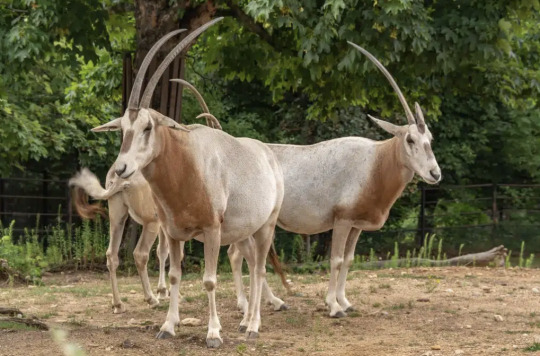
“Eight years following the first reintroductions of the species in a protected range in Chad, the species has been downlisted to ‘Endangered’ [an improvement from “extinct in the wild”] in the most recent IUCN Red List update.”
2. Thailand moves closer to legalising same-sex marriage

“Under the law, it describes a marriage union as one between two individuals, rather than a man and a woman. It will give LGBTQ+ couples the ability to adopt, have equal access to marital tax savings, rights to property and the ability to decide medical treatment when their partner is incapacitated.”
3. Juvenile platypus found in NSW: a sign of breeding success
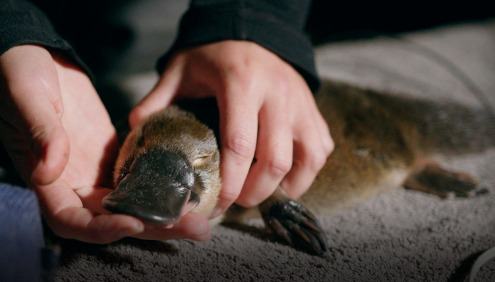
“A baby platypus was discovered in the Royal National Park less than a year after 10 were reintroduced to the area, marking the end of a half-century local extinction. […] “Finding the juvenile platypus is a clear sign the reintroduced population is not just surviving but thriving, adapting well to their environment, and contributing to the genetic diversity and resilience of this iconic species.””
4. New Laws Protect Bird-Friendly Yards From Neighborhood Rules
“A blossoming legislative trend prevents homeowners associations, which set landscaping rules for a growing number of Americans, from forbidding native plants.”
5. Bookstores Around The World Are Flourishing Again

“[I]t’s not just the major chains like Barnes & Noble that are flourishing, as the US book sales market continues to both grow and diversify, the majority of the retail book market is controlled by small indie stores.”
6. 'Like a luxury condominium': Providence zoo unveils new red panda habitat

“"Kendji and Zan's new home boasts a spacious two-story, climate-controlled indoor space designed to mimic their natural Himalayan habitat," the zoo said in a news release. "This ensures their well-being regardless of fluctuating Rhode Island temperatures and humidity."”
7. The first CULTIVATE Mobile Research Lab on food sharing in Barcelona
“[Volunteers] engaged in growing, cooking and eating food together, and redistributing surplus food, as well as other actors involved in food sharing and sustainable food systems in Barcelona and its surroundings.”
8. New Methane Rule Will Reduce Natural Gas Waste, Generate Money for Taxpayers, Help Address Climate Change

“The Bureau of Land Management’s final rule on reducing methane waste from oil and gas production on public lands will conserve critical energy resources, with the added benefit of decreasing toxic pollution [….] The rule will benefit wildlife, public lands, water resources, and nearby communities. By requiring royalties for wasted methane, the rule will also generate more than $50 million each year for American taxpayers.”
9. 'Exceptional' Two-Headed Snake Undergoes Surgery in Missouri

“Tiger-Lily's [the snake’s] abnormal ovaries were then removed during surgery at the Saint Louis Zoo Endangered Species Research Center and Veterinary Hospital on March 11. The procedure went smoothly, with her ovaries being successfully removed, and the snake is recovering well.”
10. Aruba Embraces the Rights of Nature and a Human Right to a Clean Environment

“A draft constitutional amendment would make the Carribean nation the second country in the world to recognize that nature has the right to exist.”
March 15-21 news here | (all credit for images and written material can be found at the source linked; I don’t claim credit for anything but curating.)
#hopepunk#good news#deer#conservation#endangered#animals#africa#thailand#lgbtq#gay rights#gay marriage#same sex marriage#platypuses#australia#hoa#native plants#wildflowers#bookstore#books#zoo#red panda#barcelona#spain#food#food insecurity#interdependence#natural gas#climate change#snake#palm beach
7 notes
·
View notes
Note
Dorlily
Damn pickles, making me work up a sweat by answering all of them.
1.) What’s their love language?
Quality time for sure. It’s hard for them to spend much time together as they’re in different houses so they take advantage of every opportunity to be together.
2.) Do they have a dynamic trope?
Academic rivals, bickering married couple, “I’d die for you” x “I’ll kill for you”
3.) Who cooks? Who cleans up? Who’s banned from the kitchen?
They take turns cooking and they always clean up together. Unless one of them is stressed or tired, then the other sends them up to bed.
4.) What’s their favorite sleeping/cuddling positions?
Lily as the big spoon and Dorcas as the little spoon. Lily also likes to lay on Dorcas’ chest.
5.) Who does what chores?
Lily dusts and waters the plants, Dorcas does the laundry and vacuums because Lily refuses. They make James clean their bathroom.
6.) Do they go out often or prefer to stay indoors?
They like to stay indoors and paint or watch a movie.
7.) Who is the more romantic one?
Dorcas
8.) Do they have a favorite activities to do together?
Tending to their garden, watching tv, and shit talking people <3
9.) Baths or showers together? Do they like elaborate ones with bubbles and flower petals?
They honestly prefer to shower/bathe separately most of the time. But they’ll keep the other company while they’re in the bath.
10.) Who drives and who picks out the music?
Dorcas drives and they fight over the music (lily usually wins).
11.) What’s a song that describes their relationship? Or what’s the song that they’ve deemed “their” song?
Bad Idea by Girl in Red is a very dorlily coded song imo. They always do a dramatic rendition of ‘I Will Always Love You’ by Dolly Parton on Karaoke night so it’s kinda become the song all their friends associate them with.
12.) Who gets up the earliest? Who has the worst sleep schedule? Who is the sleepiest?
Somehow Lily, for all of these. She goes to bed at 5am and then wakes up at 8am ready to take on the day. But then she always takes a nap around 4pm.
13.) What’s their opinions on PDA?
They try to keep their relationship a secret so they’re not very fond of it. But they will sneak a quick ass grab in the hallways.
14.) Who does fashion shows after a mall trip and who watches and compliments them?
Lily does the fashion show and Dorcas watches. She makes sure to applaud every-time Lily twirls in her new skirt.
15.) Do they go on vacations together? Where is their favorite place to visit?
Not really, they usually just go to the beach.
16.) What’s their favorite “domestic bliss” moment? Do they cook/clean together? Do they like to go out shopping together?
They co-parent plants together and wash the dishes together. They’re not allowed to go shopping together because they encourage each other buy everything they look at.
17.) What does a relaxing night in look like for them?
Watching a movie and napping on the couch
18.) What does a date night out look like for them?
They go the drive in and make out in the backseat <3 (can you tell they’re a movie couple?)
19.) How do they silently/subtly express their love for each other?
Dorcas runs bathes for Lily when she’s stressed. Lily gives Dorcas massages after quidditch games.
20.) What clothes/accessories do they steal from each other?
They wear each other’s ties a lot because they like feeling like the other belongs to them. They’re also the same shoe size so they accidentally put on each other’s shoes and it’s how people end up figuring out they’re together.
21.) Which of their friends/family pokes fun at them for them getting flustered/affectionate?
Sirius and Marlene mock them all the time.
22.) How do they apologize after arguments?
They’ll make the other’s favorite food as a peace offering.
23.) Do they like pick up lines?
No. Absolutely not.
24.) What are their favorite places to kiss on their partner? What are their favorite types of kisses?
Neck kisses!!! With an affectionate nip added!!
25.) What is their dream home? Do they buy a place together? Who plans the decorations and who does the heavy lifting?
They like the idea of living in a ranch together, but they end up just living in a little cottage. They both plan the decorations and Marlene does the heavy lifting.
26.) Do they have any pets or kids?
For some reason, birds really like their windowsill and Lily always ends up feeding them. Dorcas comes home with an injured frog one day and the next morning she finds it with a mini bandana on.
27.) Who would propose? What would their wedding be like?
Lily proposes and they end up eloping.
28.) What’s something that reminds them of their partner? Do they have anything on them daily as a reminder (a photo, phone background, tattoo, clothing/accessory, etc.)?
Dorcas gives Lily her quidditch jersey. Dorcas has a lily tattoo on her collarbone and Lily has a meadow on hers.
29.) What is something they can never agree on? How do they meet in the middle?
Constantly argue over small things. Lily has no idea how to flip off light switches.
30.) Free space! Say something about this ship that you want to say!
I love them so much, I need to inject them into my bloodstream. Also they’re better than dorlene and marylily. Sorry not sorry.
9 notes
·
View notes
Text
Angstober 10: Can't Go Home
Ugh, I'm so behind at posting these. 😅 I've been producing flash fics fairly reliably, but getting into the right mindset for editing them is another matter.
Anyway, this is another instance at poking at that one ever-growing plot bunny. Links to previous installments: [1], [2], [3], [4]
Alita longed to go home, and she didn’t even know what she meant by that.
The capital steered up a whirlwind old memories. The kind of memories she’d firmly believed were her sister’s domain. She had been, after all, too young when she was spirited away to the outskirts of the kingdom. How could she possibly retain anything but the vaguest impressions of being a babe here at court, hiding behind her mother’s skirts or bouncing on her father’s knee? Surely every image that ever flickered in her mind was at least halfway a product of her imagination.
And yet now that she walked the marble-lined paths of the indoors garden, she was struck by the familiarity of it all. She’d round a corner, and recognize something: a red-barked tree with its leaves eternally gilded, or a peculiar formation of rose bushes. A scent in the air. A particularly slippery patch of stone under the soft soles of her shoes. All of it felt like something she’d once had and could never get back again, even though here she was, existing awkwardly in the middle of it all.
Perhaps it was her imagination. After all, it had been a decade. Even more than that. It seemed inconceivable for the palace to spend all that time suspended in limbo, awaiting her return. Within this buoyant heart of the kingdom, changed happened rapidly. Styles went out of fashion as swiftly as summer butterflies back in Longhills changed their colors. It must be true for gardening as well as hairdos and dresses.
Longhills. Another home she painfully missed. The comfort of her uncle’s mansion, the predictability of her days there. Long evenings by the fire. Books and chess. Helping the old cook, Ghilta, around the kitchen even though she wasn’t supposed to. Feeding seeds and fresh peas to the starlings that lived in the garden right outside her room. Planting gardenias and lilies. Finding purpose in every moment of the day.
Here, she had nothing to do except follow her uncle around—and even that wasn’t always an option. Like now. He’d brought her here to the gardens so that they could discreetly observe the courtiers, then find a secluded place to discuss the recent developments. However, they’d barely stepped inside when a servant called after them, an old man with a bushy beard and the King’s personal insignia plastered proudly over his blue livery. He’d spoken to Uncle Rythan in a whisper too low for Alita to hear and pushed something into his hands before disappearing behind a wall of vibrant succulents. Alita watched her uncle grow tight-lipped and still.
“It won’t take long,” he had promised her, neglecting as usual to explain what it meant. “You just take a walk here, all right? Keep your eyes and ears open and make sure not to wander too far from the gates. I’ll be with you anon.”
At least an hour had elapsed since, if her inner clock could be trusted at all. Alita had done her best to follow her uncle’s guidance, strolling back and forth along the same semi-circular path, except she must have got lost in thought and taken a wrong turn at some point, because she could no longer see the entrance. Everywhere she turned her gaze, there were trees and blossoms, hedges and complicated arrangements of rocks. She heard no voices and saw no bejeweled fabrics.
Helplessly, she looked around once more. Now how was her uncle going to find her? The entrance was in the western part of this fake park, she remembered that much. It did little to help her, though. If this was a real garden, she could have relied on the position of the sun and the natural growth patterns of plants to orient herself. Here, it was useless. Everything was artificial. Whatever light filtered through the vaulted stained glass ceiling got hopelessly distorted by the kaleidoscopic mosaic.
What a stupid fool she was, to get lost in what was essentially a single big room full of plants! Alita drew a shuddery breath, wrapping her arms around herself. Uncle Rythan had misjudged her. He should have brought Norra. Her sister would take to court like a bird to the sky. So what if she would be a little distracted? Uncle Rythan didn’t need as much input as he’d claimed he would. They’d hardly been talking at all this entire week.
I don’t know what I’m doing, she admitted to herself with a sinking heart, and the thought applied to so much more than her current predicament.
The paths and the trees that had felt so achingly familiar a moment ago were now a strange maze, a trap closing in on her. Alita gulped. She needed to retrace her steps—an obvious, sane choice—but she’d been stuck in place for a little too long and she didn’t know whether she should go left or right.
Norra would go for a third option. But there wasn’t—
Wait. No. There was.
Between two swirling flower beds, there lay another path, a narrower one leading deep into a copse of unnaturally lush lilac trees.
Weren’t there lilacs in front of the entrance, too?
It was this, or do nothing. Alita squared her shoulders and stepped forth. The lace-trimmed hem of her dress kissed golden sand instead of marble; her silk-clad feet drowned in the softness. Was this passage even made for the noble guests’ walking, or was she intruding upon the servants’ territory? How absurd was this thought?
The trees closed rank in front of her, branches covered in thorns that lilacs weren’t supposed to have. She pushed one aside, then another. A thorn caught on one of her narrow sleeves, digging deep into the seam and her goosebump-covered flesh underneath. Alita yelped.
“Who goes there?”
She froze at the sharp male voice, then hastened to step back. Too late.
The branches unfolded in front of her, as if by magic, revealing a small clearing. Two men stood there, intimately close together. One of them was of a smaller height than average, with a nondescript face and shrewd eyes. The other...
Alita barely suppressed a gasp.
“Your Highness.” She fumbled with her skirts in the best version of a formal curtsy she was capable of. She suspected it wasn’t a seemly sight. It never was with her, no matter how often she practiced. “I’m so incredibly sorry to intrude—”
“I’m certain you are.” It was a wonder no leaves shriveled or frosted over from the chill in Prince Cassar’s voice. “I would expect nothing less from a court guest devoid of any rights or privileges, intentionally caught in the act of spying on the heir to the throne.”
“I wasn’t...” She made the mistake of looking up. Under the weight of his glare, the words withered in her throat.
What had she got herself into?
#warden's random scribbles#writeblr#original fiction#snippet#angstober2023#day 10#fantasy#court intrigue#homesickness#writers on tumblr#my writing
5 notes
·
View notes
Text
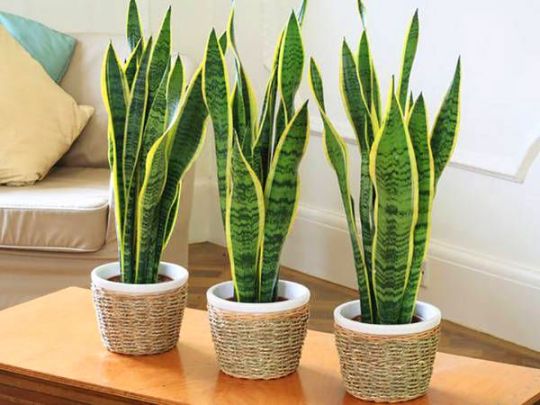
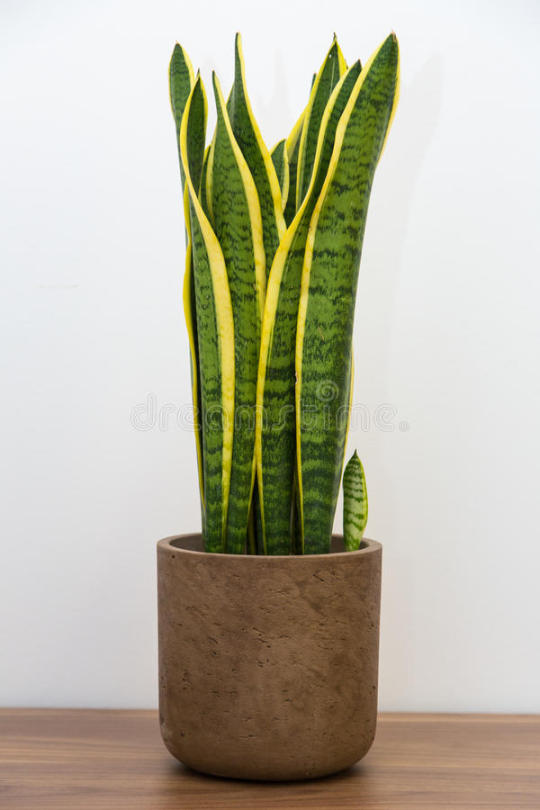
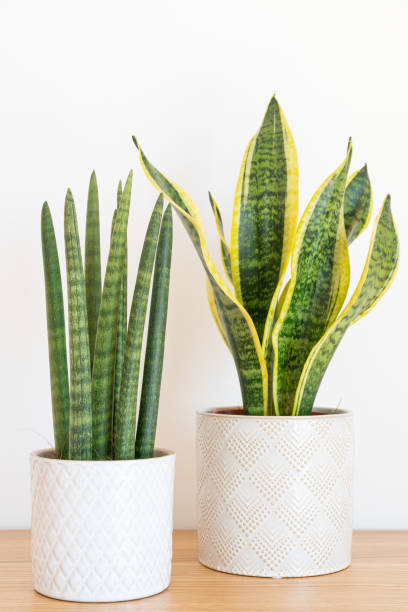
Snake Plant Sansevieria (also called Snake Plant) Dracaena trifasciata ‘Laurentii’ Adored by generations of houseplant owners for its ease of growth, this variety won the Award of Garden Merit from the Royal Horticultural Society of the UK in 1993 and is still popular today. This species is native to areas of Western Africa and is often enjoyed in planters in decks and patios in addition to its common use as a houseplant. It’s relatively slow-growing, especially in low-light conditions (which it tolerates well). Its vertical growth makes is perfect for small spaces, as well as contemporary/modern decorating schemes. One of the most forgiving and durable indoor plants you can grow, Laurentii Snake Plant (botanically Dracaena trifasciata ‘Laurentii’, formerly Sansevieria trifasciata ‘Laurentii’) features mint-green leaves banded with horizontal dark green stripes and golden-yellow leaf edges. It typically grows 24 to 36 inches tall indoors. It is grown and shipped fresh from our farm direct to your front door. Easy to grow houseplant and perfect for houseplant beginners. Variegated foliage adds a distinctive look to your home all year long. Excellent for homes and offices.
it’s among the easiest to grow and care for. So much so that it doesn’t need sunlight, the artificial light found in the typical office is perfectly fine. It can go weeks without watering, and it tolerates low levels of humidity.
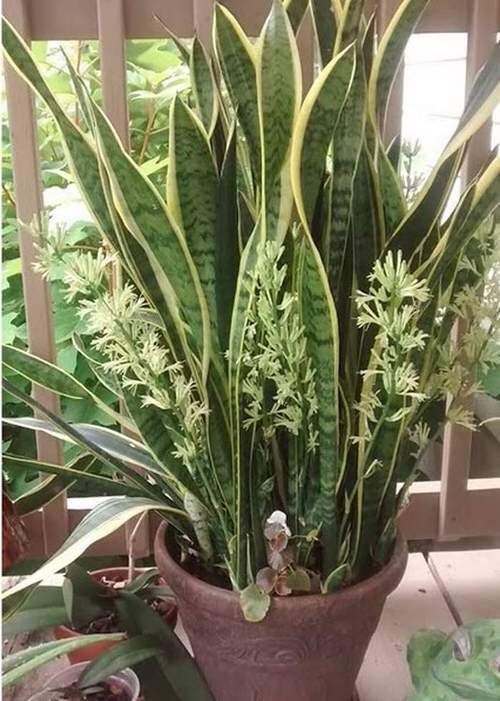
You might have never seen a snake plant flower as it’s quite rare. However, it is possible for you to experience it if you follow the right steps. Let’s have a look at some tricks on How to Get a Snake Plant to Bloom!
How to Get a Snake Plant to Bloom (Highly Fragrant & Rare)
youtube
You might have never seen a snake plant flower as it’s quite rare. However, it is possible for you to experience it if you follow the right steps. Let’s have a look at some tricks on How to Get a Snake Plant to Bloom!
Do Snake Plants Flower? The straight answer to the question is, Yes! They do! This happens once annually, usually during spring or summer, if the conditions meet. However, it is still extremely uncommon but possible. You also have to bear the fact in mind that if you have grown Sansevieria trifasciata ‘Hahnii,’ then it won’t bloom, no matter what.
Snake Plant Flower Appearance Snake plant flowers grow around tall spikes or stalks. The stalks grow up to several inches or feet tall and are full of small, lily, or honeysuckle-like, tubular, cream, green, or white narrow-petaled clusters of blooms–all this depends on the type of snake plant. According to the variety, some cultivars have white with a hint of mauve or lavender. Some species show off bright red blossoms. Some varieties of mother-in-law’s tongue do not have a flower stalk, and they directly blossom from the base in huge clusters.
Snake Plant Flower Smell The snake plant flowers are highly fragrant and emit a spicy vanilla-like scent that you can’t compare with anything. The blooms also produce sweet-scented nectar, so much in fact that it can drip down the stalk! Flowers close in the daytime and open up during the night. The fragrance becomes very strong after it gets dark.
How to Get a Snake Plant to Bloom? There’s no guarantee that the snake plant you have will bloom. However, there are certain factors that might help it flower. The best way to make snake plants bloom is to keep them in a root-bound stage and expose them to a lot of sunlight. Most people keep this in extremely low light or shade, which will prevent the plant from flowering. Keeping them outdoors or near a window that receives some direct light can induce flowering. When the plant is watered less and is kept in good light, it grows quickly, thereby filling up the pot in no time. When the roots have no more space to grow and the pot gets filled with them, the plant flowers to propagate itself. Generally, new and young snake plants do not flower. You will have more chances of flowering with an aged specimen. Keeping the plant in a slightly stressed state, along with low fertilization, can also trick it into blooming flowers. Avoid keeping the plant in shade for a longer duration of time. Always make sure that the plant gets a minimum of 3-4 hours of direct sun each day. The best bet is to keep it near an east-facing window. Do not overwater the plant in any case.
The Bottom Line These pointers will certainly help it bloom, but these serve no surety that doing this will make every snake plant flower! It seems certain conditions force this amazing houseplant to bloom, or you can say these plants have a mind of their own when it comes to blooming.
3 notes
·
View notes
Text
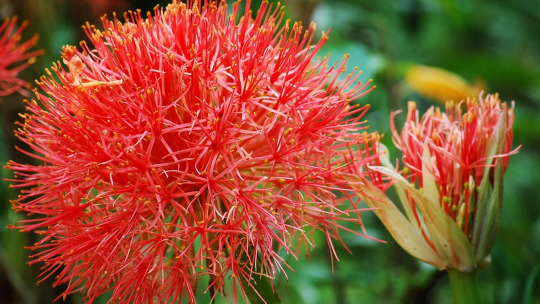
Scadoxus multiflorus, commonly known as the blood lily or fireball lily, is a stunning flowering plant native to various parts of Africa, including South Africa. It belongs to the Amaryllidaceae family and is known for its striking, spherical clusters of bright red or orange-red flowers. Here are some key characteristics and information about Scadoxus multiflorus: 🌺 Scadoxus multiflorus: Also known as the Blood Lily or Fireball Lily, it's a stunning flowering plant native to various parts of Africa, including South Africa. 🌼 Appearance: The most distinctive feature is its round flower head, measuring up to 4-6 inches (10-15 cm) in diameter. The individual flowers are small and tubular, densely packed together in the flower head, creating a ball-like appearance. Colors range from bright red to orange-red. 🌿 Foliage: Large, glossy, lance-shaped leaves emerge from the base, growing up to 18 inches (45 cm) long, providing an attractive backdrop to the vibrant flowers. 🌱 Growth Habit: A perennial plant that grows from a bulb, typically clump-forming, reaching a height of 12-18 inches (30-45 cm). 🌸 Bloom Time: Blooms in late spring or early summer, with long-lasting flowers that can persist for several weeks. ☀️ Sunlight Requirements: Prefers partial to full shade, often grown as understory plants in woodland or shaded garden areas. 🏡 Soil Requirements: Ideal in well-draining, rich, and organic soil. Avoid waterlogged soil, as it can lead to bulb rot. 💧 Watering: Keep soil consistently moist during the growing season, reducing watering during the dormant period in late summer to early fall. ❄️ Hardiness: Not frost-tolerant, typically grown as a houseplant or in regions with mild winters. Can be brought indoors in colder climates during the winter. 🌱 Propagation: Propagate by dividing bulbs when dormant. Wait until foliage dies back, then carefully separate and replant bulbs. ⚠️ Toxicity: All parts of Scadoxus multiflorus, especially the bulbs, contain toxic compounds that can be harmful if ingested. Keep it out of reach of children and pets. Scadoxus multiflorus is a striking and unique plant, perfect for adding a burst of color to shaded garden areas or indoor spaces. Its bright red or orange-red spherical blooms make it a popular choice for gardeners and plant enthusiasts seeking a distinctive addition to their collection.
2 notes
·
View notes
Text
𝟮𝟬𝟮𝟯 𝗠𝗼𝘁𝗵𝗲𝗿'𝘀 𝗗𝗮𝘆 𝗚𝗶𝗳𝘁 𝗜𝗱𝗲𝗮𝘀 𝗣𝗵𝗶𝗹𝗶𝗽𝗽𝗶𝗻𝗲𝘀: 𝗚𝗶𝘃𝗲 𝘁𝗵𝗲 𝗣𝗲𝗿𝗳𝗲𝗰𝘁 𝗚𝗶𝗳𝘁 𝘁𝗼 𝘁𝗵𝗲 𝗪𝗼𝗺𝗮𝗻 𝗪𝗵𝗼 𝗛𝗮𝘀 𝗘𝘃𝗲𝗿𝘆𝘁𝗵𝗶𝗻𝗴
Mother's Day is a wonderful opportunity to express your love and appreciation for your mom, who has been there for you through thick and thin. She has nurtured you, taught you, supported you, and inspired you in so many ways. She deserves to be pampered and spoiled on this special day. In the Philippines, Mother's Day is celebrated by most people on the second Sunday of May, which falls on May 14th, 2023. It is not an official public holiday, but it is a very popular and festive occasion. Filipinos have a deep respect and affection for their mothers, who are called the "ilaw ng tahanan", which means "the light of the home". They are the ones who bring joy and warmth to the family.
Mother's Day is a time to show appreciation for all the hard work and sacrifices our mothers have made for us. Finding the perfect gift can be a challenge, especially if your mom seems to have everything. Luckily, FloristManila.com has a wide range of gift options that are sure to impress even the most discerning moms. Here are some unique 2023 Mother's Day gift ideas that you can find on our website:
Mother's Day Flowers: Flowers are a classic and timeless way to show your love and admiration for your mom. You can choose from our variety of roses, carnations, lilies, orchids, sunflowers, gerberas, tulips, and more. You can also opt for a mixed bouquet or an arrangement that suits your mom's personality and style. We have flowers for every budget and occasion.
Flowers Basket: If you want to make your gift more impressive and elegant, you can go for a flowers basket that contains an assortment of fresh and colorful blooms. Our flowers baskets are designed with care and creativity to make them stand out and last longer. They are perfect for decorating any room or table and adding some charm and fragrance.
Fruit Baskets: If your mom is health-conscious or loves fresh produce, a fruit basket is an excellent gift option. Our fruit baskets are filled with a variety of fresh, seasonal fruits, including mangoes, pineapples, apples, and grapes. They are beautifully arranged and can be customized to suit your mom's taste preferences. You can even add a personalized message to make the gift extra special.

Combo Gifts: If you want to spoil your mom with more than one gift, you can opt for our combo gifts that combine two or more items that complement each other. For example, you can choose a combo of flowers and cake, flowers and chocolates, flowers and teddy bear, roses with balloons, or any other combination that you think your mom will love. Our combo gifts are great value for money
Mother's Day Cake: A cake is always a good idea when it comes to gifting. And what better way to celebrate Mother's Day than with a scrumptious cake that your mom will enjoy? We have a variety of cakes for Mother's Day that come in different flavors, sizes, shapes, and designs. You can choose from our classic flavors such as chocolate, red velvet, mango, blueberry, black forest, and more.
Plants: Plants are a wonderful gift for your mom if she loves nature or has a green thumb. They will bring some life and freshness to her home or office. We have a range of plants for Mother's Day that are easy to care for and beautiful to look at. You can choose from our bonsai, orchids, lucky bamboo, flower plants or other indoor plants that will purify the air and boost the mood. Our plants come in attractive pots and containers that will suit any decor and style.
Mother's Day Gift Baskets: If you're still unsure about what to get your mom, why not go for a Mother's Day gift basket? Our gift baskets are filled with a variety of goodies, including chocolates, fruits, and beauty products. You can choose from our pre-designed gift baskets or create your own by selecting the items you think your mom will love. We also offer same-day delivery for gift baskets in Metro Manila.
In conclusion, finding the perfect gift for your mom doesn't have to be a daunting task. At FloristManila.com, we offer a wide range of gift options that are sure to impress. Whether your mom loves flowers, fruits, chocolates, or plants, we have something for everyone. Show your appreciation and love for your mom this 2023 Mother's Day with a thoughtful and unique gift from FloristManila.com.
2 notes
·
View notes
Photo

Hi GPODers! Today a contributor has answered our call for summer color with a collection of blooms in just about every shade imaginable. Hugh Locke in New York has shared some seriously colorful photos in his previous submissions (Hugh’s Celebration of Annuals From Seed, Some Plants Worth Growing, Close-ups in Hugh’s Garden, etc.), many of which are his stunning ‘flower portraits’ that he also shares regularly on his Instagram (@hugh.locke). In this submission he’s diving deep into an absolutely impressive border he created last summer: I created a vibrant 80-foot-long flower border in Westchester with an array of annuals and perennials, the majority of which I grow from seed. The photos here are from last summer. My approach is based on the classic English flower border that mixes colors and textures with a gradation of height from front to back. It is also deep enough to accommodate a wide variety of flowers that are positioned to ensure a continuous show all season long. One of the highlights of last summer was this orange and yellow snapdragon (Antirrhinum majus ‘Potomac Orange’, annual) that was grown from seed and rebloomed on cue. Part of the fun is putting different flowers together to see what happens. Here the experiment worked out with a purple blue dwarf ‘Aloha Blue’ ageratum (Ageratum houstonianum ‘Aloha Blue’) (Ageratum houstonianum ‘Aloha Blue’, annual) that bloomed continuously until frost. The zinnias were similarly in full bloom until frost, from left to right: ‘Profusion Double Hot Cherry’, ‘Profusion Double Deep Salmon’, ‘Zahara Starlight Rose’, and Profusion Apricot’. The focal point of a different section of the border is ‘Musifolia’ canna (Canna ‘Musifolia’, Zones 7–10). This is the world’s tallest known variety, which topped out last summer at 8 feet tall. While it has modest red blooms late in the season, the leaves are its best feature. White flowers can sometimes get lost, but these two stand out against a hedge and some canna: Culver’s root (Veronicastrum virginicum, Zones 3–8) on the left and woodland tobacco (Nicotiana sylvestris, Zones 10–11 or as an annual) with its fireworks of trumpet flowers on the right. Hugh has been experimenting with coleus, with this variety a clear winner ‘Colocha Rose’ coleus (Plectranthus scutellarioides ‘Colocha Rose’, Zones 10–11 or as an annual) when grown next to ‘Profusion Apricot’ zinnias. This image shows off the range of colors and textures to maximum effect. Pink cosmos (Cosmos bipinnatus ‘Rosetta’, annual) and blue salvia (Salvia farinacea ‘Victoria Blue’, Zones 8–10 or as an annual) are in front of striking yellow goldenrod (Solidago), next to which is lacy white yarrow (Achillea millefolium, Zones 3–9)… all grown from seed, with the perennials now a few years old. ‘Casa Blanca’ Oriental lilies (Lilium ‘Casa Blanca’, Zones 5–8) steal the show, with a backdrop of violet cleome (Cleome hassleriana ‘Violet Queen’, annual). To the right are perennial Shasta daisies (Leucanthemum ‘Madonna’, Zones 3–9) grown from seed last spring and happily flowering their first year out. Yet another section of the border is dominated by this giant castor bean (Ricinus communis ‘Zanzibariensis’, Zones 9–11 or as an annual). An annual grown from seed, this tropical beauty eventually reached 14 feet by the end of the season. At that point the stem was the diameter of a small tree trunk and digging up the deep root system was a major undertaking. This celosia (Celosia plumosa ‘Yachiyo Hiryu’, annual) was a new addition last year and is now on the permanent list of annuals. Each year I starts seeds indoors under lights, beginning in February. While most are annuals, each year there are a few perennials (some of which admittedly take two years to put on a show of flowers). Last spring the result was close just over 350 plants in 4 inch pots ready for transplanting. Here are just a few examples of the closeup flower portraits from my garden you can see on my Instagram. Thank you so much for another memorable submission, Hugh! As many of us look out into gray, white, and brown landscapes of winter, your plant portraits and colorful garden combinations are a much-needed reminder of the warmth and color that awaits us later in the year. Have a garden you’d like to share? Have photos to share? We’d love to see your garden, a particular collection of plants you love, or a wonderful garden you had the chance to visit! To submit, send 5-10 photos to [email protected] along with some information about the plants in the pictures and where you took the photos. We’d love to hear where you are located, how long you’ve been gardening, successes you are proud of, failures you learned from, hopes for the future, favorite plants, or funny stories from your garden. Have a mobile phone? Tag your photos on Facebook, Instagram or Twitter with #FineGardening! Do you receive the GPOD by email yet? Sign up here. Fine Gardening Recommended Products Planting in a Post-Wild World: Designing Plant Communities for Resilient Landscapes Fine Gardening receives a commission for items purchased through links on this site, including Amazon Associates and other affiliate advertising programs. Featuring gorgeous photography and advice for landscapers, Planting in a Post-Wild World by Thomas Rainer and Claudia West is dedicated to the idea of a new nature—a hybrid of both the wild and the cultivated—that can nourish in our cities and suburbs. Attracting Beneficial Bugs to Your Garden, Revised and Updated Second Edition: A Natural Approach to Pest Control Fine Gardening receives a commission for items purchased through links on this site, including Amazon Associates and other affiliate advertising programs. This revised and updated edition of Jessica Walliser’s award-winning Attracting Beneficial Bugs to Your Garden offers a valuable and science-backed plan for bringing balance back to the garden. With this indispensable gardening reference—now updated with new research, insights, and voices—learn how to create a healthy, balanced, and diverse garden capable of supporting a hard-working crew of beneficial pest-eating insects and eliminate the need for synthetic chemical pesticides. The Crevice Garden: How to make the perfect home for plants from rocky places Fine Gardening receives a commission for items purchased through links on this site, including Amazon Associates and other affiliate advertising programs. A crevice garden replicates the environmental conditions of mountain tops, deserts, coastlines, and other exposed or rocky places on earth. These striking garden features provide perfect conditions for the plants native to these far-off places, bringing the cultivation of these precious gems within everybody’s reach. Source link
0 notes
Photo

Hi GPODers! Today a contributor has answered our call for summer color with a collection of blooms in just about every shade imaginable. Hugh Locke in New York has shared some seriously colorful photos in his previous submissions (Hugh’s Celebration of Annuals From Seed, Some Plants Worth Growing, Close-ups in Hugh’s Garden, etc.), many of which are his stunning ‘flower portraits’ that he also shares regularly on his Instagram (@hugh.locke). In this submission he’s diving deep into an absolutely impressive border he created last summer: I created a vibrant 80-foot-long flower border in Westchester with an array of annuals and perennials, the majority of which I grow from seed. The photos here are from last summer. My approach is based on the classic English flower border that mixes colors and textures with a gradation of height from front to back. It is also deep enough to accommodate a wide variety of flowers that are positioned to ensure a continuous show all season long. One of the highlights of last summer was this orange and yellow snapdragon (Antirrhinum majus ‘Potomac Orange’, annual) that was grown from seed and rebloomed on cue. Part of the fun is putting different flowers together to see what happens. Here the experiment worked out with a purple blue dwarf ‘Aloha Blue’ ageratum (Ageratum houstonianum ‘Aloha Blue’) (Ageratum houstonianum ‘Aloha Blue’, annual) that bloomed continuously until frost. The zinnias were similarly in full bloom until frost, from left to right: ‘Profusion Double Hot Cherry’, ‘Profusion Double Deep Salmon’, ‘Zahara Starlight Rose’, and Profusion Apricot’. The focal point of a different section of the border is ‘Musifolia’ canna (Canna ‘Musifolia’, Zones 7–10). This is the world’s tallest known variety, which topped out last summer at 8 feet tall. While it has modest red blooms late in the season, the leaves are its best feature. White flowers can sometimes get lost, but these two stand out against a hedge and some canna: Culver’s root (Veronicastrum virginicum, Zones 3–8) on the left and woodland tobacco (Nicotiana sylvestris, Zones 10–11 or as an annual) with its fireworks of trumpet flowers on the right. Hugh has been experimenting with coleus, with this variety a clear winner ‘Colocha Rose’ coleus (Plectranthus scutellarioides ‘Colocha Rose’, Zones 10–11 or as an annual) when grown next to ‘Profusion Apricot’ zinnias. This image shows off the range of colors and textures to maximum effect. Pink cosmos (Cosmos bipinnatus ‘Rosetta’, annual) and blue salvia (Salvia farinacea ‘Victoria Blue’, Zones 8–10 or as an annual) are in front of striking yellow goldenrod (Solidago), next to which is lacy white yarrow (Achillea millefolium, Zones 3–9)… all grown from seed, with the perennials now a few years old. ‘Casa Blanca’ Oriental lilies (Lilium ‘Casa Blanca’, Zones 5–8) steal the show, with a backdrop of violet cleome (Cleome hassleriana ‘Violet Queen’, annual). To the right are perennial Shasta daisies (Leucanthemum ‘Madonna’, Zones 3–9) grown from seed last spring and happily flowering their first year out. Yet another section of the border is dominated by this giant castor bean (Ricinus communis ‘Zanzibariensis’, Zones 9–11 or as an annual). An annual grown from seed, this tropical beauty eventually reached 14 feet by the end of the season. At that point the stem was the diameter of a small tree trunk and digging up the deep root system was a major undertaking. This celosia (Celosia plumosa ‘Yachiyo Hiryu’, annual) was a new addition last year and is now on the permanent list of annuals. Each year I starts seeds indoors under lights, beginning in February. While most are annuals, each year there are a few perennials (some of which admittedly take two years to put on a show of flowers). Last spring the result was close just over 350 plants in 4 inch pots ready for transplanting. Here are just a few examples of the closeup flower portraits from my garden you can see on my Instagram. Thank you so much for another memorable submission, Hugh! As many of us look out into gray, white, and brown landscapes of winter, your plant portraits and colorful garden combinations are a much-needed reminder of the warmth and color that awaits us later in the year. Have a garden you’d like to share? Have photos to share? We’d love to see your garden, a particular collection of plants you love, or a wonderful garden you had the chance to visit! To submit, send 5-10 photos to [email protected] along with some information about the plants in the pictures and where you took the photos. We’d love to hear where you are located, how long you’ve been gardening, successes you are proud of, failures you learned from, hopes for the future, favorite plants, or funny stories from your garden. Have a mobile phone? Tag your photos on Facebook, Instagram or Twitter with #FineGardening! Do you receive the GPOD by email yet? Sign up here. Fine Gardening Recommended Products Planting in a Post-Wild World: Designing Plant Communities for Resilient Landscapes Fine Gardening receives a commission for items purchased through links on this site, including Amazon Associates and other affiliate advertising programs. Featuring gorgeous photography and advice for landscapers, Planting in a Post-Wild World by Thomas Rainer and Claudia West is dedicated to the idea of a new nature—a hybrid of both the wild and the cultivated—that can nourish in our cities and suburbs. Attracting Beneficial Bugs to Your Garden, Revised and Updated Second Edition: A Natural Approach to Pest Control Fine Gardening receives a commission for items purchased through links on this site, including Amazon Associates and other affiliate advertising programs. This revised and updated edition of Jessica Walliser’s award-winning Attracting Beneficial Bugs to Your Garden offers a valuable and science-backed plan for bringing balance back to the garden. With this indispensable gardening reference—now updated with new research, insights, and voices—learn how to create a healthy, balanced, and diverse garden capable of supporting a hard-working crew of beneficial pest-eating insects and eliminate the need for synthetic chemical pesticides. The Crevice Garden: How to make the perfect home for plants from rocky places Fine Gardening receives a commission for items purchased through links on this site, including Amazon Associates and other affiliate advertising programs. A crevice garden replicates the environmental conditions of mountain tops, deserts, coastlines, and other exposed or rocky places on earth. These striking garden features provide perfect conditions for the plants native to these far-off places, bringing the cultivation of these precious gems within everybody’s reach. Source link
0 notes
Photo

Hi GPODers! Today a contributor has answered our call for summer color with a collection of blooms in just about every shade imaginable. Hugh Locke in New York has shared some seriously colorful photos in his previous submissions (Hugh’s Celebration of Annuals From Seed, Some Plants Worth Growing, Close-ups in Hugh’s Garden, etc.), many of which are his stunning ‘flower portraits’ that he also shares regularly on his Instagram (@hugh.locke). In this submission he’s diving deep into an absolutely impressive border he created last summer: I created a vibrant 80-foot-long flower border in Westchester with an array of annuals and perennials, the majority of which I grow from seed. The photos here are from last summer. My approach is based on the classic English flower border that mixes colors and textures with a gradation of height from front to back. It is also deep enough to accommodate a wide variety of flowers that are positioned to ensure a continuous show all season long. One of the highlights of last summer was this orange and yellow snapdragon (Antirrhinum majus ‘Potomac Orange’, annual) that was grown from seed and rebloomed on cue. Part of the fun is putting different flowers together to see what happens. Here the experiment worked out with a purple blue dwarf ‘Aloha Blue’ ageratum (Ageratum houstonianum ‘Aloha Blue’) (Ageratum houstonianum ‘Aloha Blue’, annual) that bloomed continuously until frost. The zinnias were similarly in full bloom until frost, from left to right: ‘Profusion Double Hot Cherry’, ‘Profusion Double Deep Salmon’, ‘Zahara Starlight Rose’, and Profusion Apricot’. The focal point of a different section of the border is ‘Musifolia’ canna (Canna ‘Musifolia’, Zones 7–10). This is the world’s tallest known variety, which topped out last summer at 8 feet tall. While it has modest red blooms late in the season, the leaves are its best feature. White flowers can sometimes get lost, but these two stand out against a hedge and some canna: Culver’s root (Veronicastrum virginicum, Zones 3–8) on the left and woodland tobacco (Nicotiana sylvestris, Zones 10–11 or as an annual) with its fireworks of trumpet flowers on the right. Hugh has been experimenting with coleus, with this variety a clear winner ‘Colocha Rose’ coleus (Plectranthus scutellarioides ‘Colocha Rose’, Zones 10–11 or as an annual) when grown next to ‘Profusion Apricot’ zinnias. This image shows off the range of colors and textures to maximum effect. Pink cosmos (Cosmos bipinnatus ‘Rosetta’, annual) and blue salvia (Salvia farinacea ‘Victoria Blue’, Zones 8–10 or as an annual) are in front of striking yellow goldenrod (Solidago), next to which is lacy white yarrow (Achillea millefolium, Zones 3–9)… all grown from seed, with the perennials now a few years old. ‘Casa Blanca’ Oriental lilies (Lilium ‘Casa Blanca’, Zones 5–8) steal the show, with a backdrop of violet cleome (Cleome hassleriana ‘Violet Queen’, annual). To the right are perennial Shasta daisies (Leucanthemum ‘Madonna’, Zones 3–9) grown from seed last spring and happily flowering their first year out. Yet another section of the border is dominated by this giant castor bean (Ricinus communis ‘Zanzibariensis’, Zones 9–11 or as an annual). An annual grown from seed, this tropical beauty eventually reached 14 feet by the end of the season. At that point the stem was the diameter of a small tree trunk and digging up the deep root system was a major undertaking. This celosia (Celosia plumosa ‘Yachiyo Hiryu’, annual) was a new addition last year and is now on the permanent list of annuals. Each year I starts seeds indoors under lights, beginning in February. While most are annuals, each year there are a few perennials (some of which admittedly take two years to put on a show of flowers). Last spring the result was close just over 350 plants in 4 inch pots ready for transplanting. Here are just a few examples of the closeup flower portraits from my garden you can see on my Instagram. Thank you so much for another memorable submission, Hugh! As many of us look out into gray, white, and brown landscapes of winter, your plant portraits and colorful garden combinations are a much-needed reminder of the warmth and color that awaits us later in the year. Have a garden you’d like to share? Have photos to share? We’d love to see your garden, a particular collection of plants you love, or a wonderful garden you had the chance to visit! To submit, send 5-10 photos to [email protected] along with some information about the plants in the pictures and where you took the photos. We’d love to hear where you are located, how long you’ve been gardening, successes you are proud of, failures you learned from, hopes for the future, favorite plants, or funny stories from your garden. Have a mobile phone? Tag your photos on Facebook, Instagram or Twitter with #FineGardening! Do you receive the GPOD by email yet? Sign up here. Fine Gardening Recommended Products Planting in a Post-Wild World: Designing Plant Communities for Resilient Landscapes Fine Gardening receives a commission for items purchased through links on this site, including Amazon Associates and other affiliate advertising programs. Featuring gorgeous photography and advice for landscapers, Planting in a Post-Wild World by Thomas Rainer and Claudia West is dedicated to the idea of a new nature—a hybrid of both the wild and the cultivated—that can nourish in our cities and suburbs. Attracting Beneficial Bugs to Your Garden, Revised and Updated Second Edition: A Natural Approach to Pest Control Fine Gardening receives a commission for items purchased through links on this site, including Amazon Associates and other affiliate advertising programs. This revised and updated edition of Jessica Walliser’s award-winning Attracting Beneficial Bugs to Your Garden offers a valuable and science-backed plan for bringing balance back to the garden. With this indispensable gardening reference—now updated with new research, insights, and voices—learn how to create a healthy, balanced, and diverse garden capable of supporting a hard-working crew of beneficial pest-eating insects and eliminate the need for synthetic chemical pesticides. The Crevice Garden: How to make the perfect home for plants from rocky places Fine Gardening receives a commission for items purchased through links on this site, including Amazon Associates and other affiliate advertising programs. A crevice garden replicates the environmental conditions of mountain tops, deserts, coastlines, and other exposed or rocky places on earth. These striking garden features provide perfect conditions for the plants native to these far-off places, bringing the cultivation of these precious gems within everybody’s reach. Source link
0 notes
Photo

Hi GPODers! Today a contributor has answered our call for summer color with a collection of blooms in just about every shade imaginable. Hugh Locke in New York has shared some seriously colorful photos in his previous submissions (Hugh’s Celebration of Annuals From Seed, Some Plants Worth Growing, Close-ups in Hugh’s Garden, etc.), many of which are his stunning ‘flower portraits’ that he also shares regularly on his Instagram (@hugh.locke). In this submission he’s diving deep into an absolutely impressive border he created last summer: I created a vibrant 80-foot-long flower border in Westchester with an array of annuals and perennials, the majority of which I grow from seed. The photos here are from last summer. My approach is based on the classic English flower border that mixes colors and textures with a gradation of height from front to back. It is also deep enough to accommodate a wide variety of flowers that are positioned to ensure a continuous show all season long. One of the highlights of last summer was this orange and yellow snapdragon (Antirrhinum majus ‘Potomac Orange’, annual) that was grown from seed and rebloomed on cue. Part of the fun is putting different flowers together to see what happens. Here the experiment worked out with a purple blue dwarf ‘Aloha Blue’ ageratum (Ageratum houstonianum ‘Aloha Blue’) (Ageratum houstonianum ‘Aloha Blue’, annual) that bloomed continuously until frost. The zinnias were similarly in full bloom until frost, from left to right: ‘Profusion Double Hot Cherry’, ‘Profusion Double Deep Salmon’, ‘Zahara Starlight Rose’, and Profusion Apricot’. The focal point of a different section of the border is ‘Musifolia’ canna (Canna ‘Musifolia’, Zones 7–10). This is the world’s tallest known variety, which topped out last summer at 8 feet tall. While it has modest red blooms late in the season, the leaves are its best feature. White flowers can sometimes get lost, but these two stand out against a hedge and some canna: Culver’s root (Veronicastrum virginicum, Zones 3–8) on the left and woodland tobacco (Nicotiana sylvestris, Zones 10–11 or as an annual) with its fireworks of trumpet flowers on the right. Hugh has been experimenting with coleus, with this variety a clear winner ‘Colocha Rose’ coleus (Plectranthus scutellarioides ‘Colocha Rose’, Zones 10–11 or as an annual) when grown next to ‘Profusion Apricot’ zinnias. This image shows off the range of colors and textures to maximum effect. Pink cosmos (Cosmos bipinnatus ‘Rosetta’, annual) and blue salvia (Salvia farinacea ‘Victoria Blue’, Zones 8–10 or as an annual) are in front of striking yellow goldenrod (Solidago), next to which is lacy white yarrow (Achillea millefolium, Zones 3–9)… all grown from seed, with the perennials now a few years old. ‘Casa Blanca’ Oriental lilies (Lilium ‘Casa Blanca’, Zones 5–8) steal the show, with a backdrop of violet cleome (Cleome hassleriana ‘Violet Queen’, annual). To the right are perennial Shasta daisies (Leucanthemum ‘Madonna’, Zones 3–9) grown from seed last spring and happily flowering their first year out. Yet another section of the border is dominated by this giant castor bean (Ricinus communis ‘Zanzibariensis’, Zones 9–11 or as an annual). An annual grown from seed, this tropical beauty eventually reached 14 feet by the end of the season. At that point the stem was the diameter of a small tree trunk and digging up the deep root system was a major undertaking. This celosia (Celosia plumosa ‘Yachiyo Hiryu’, annual) was a new addition last year and is now on the permanent list of annuals. Each year I starts seeds indoors under lights, beginning in February. While most are annuals, each year there are a few perennials (some of which admittedly take two years to put on a show of flowers). Last spring the result was close just over 350 plants in 4 inch pots ready for transplanting. Here are just a few examples of the closeup flower portraits from my garden you can see on my Instagram. Thank you so much for another memorable submission, Hugh! As many of us look out into gray, white, and brown landscapes of winter, your plant portraits and colorful garden combinations are a much-needed reminder of the warmth and color that awaits us later in the year. Have a garden you’d like to share? Have photos to share? We’d love to see your garden, a particular collection of plants you love, or a wonderful garden you had the chance to visit! To submit, send 5-10 photos to [email protected] along with some information about the plants in the pictures and where you took the photos. We’d love to hear where you are located, how long you’ve been gardening, successes you are proud of, failures you learned from, hopes for the future, favorite plants, or funny stories from your garden. Have a mobile phone? Tag your photos on Facebook, Instagram or Twitter with #FineGardening! Do you receive the GPOD by email yet? Sign up here. Fine Gardening Recommended Products Planting in a Post-Wild World: Designing Plant Communities for Resilient Landscapes Fine Gardening receives a commission for items purchased through links on this site, including Amazon Associates and other affiliate advertising programs. Featuring gorgeous photography and advice for landscapers, Planting in a Post-Wild World by Thomas Rainer and Claudia West is dedicated to the idea of a new nature—a hybrid of both the wild and the cultivated—that can nourish in our cities and suburbs. Attracting Beneficial Bugs to Your Garden, Revised and Updated Second Edition: A Natural Approach to Pest Control Fine Gardening receives a commission for items purchased through links on this site, including Amazon Associates and other affiliate advertising programs. This revised and updated edition of Jessica Walliser’s award-winning Attracting Beneficial Bugs to Your Garden offers a valuable and science-backed plan for bringing balance back to the garden. With this indispensable gardening reference—now updated with new research, insights, and voices—learn how to create a healthy, balanced, and diverse garden capable of supporting a hard-working crew of beneficial pest-eating insects and eliminate the need for synthetic chemical pesticides. The Crevice Garden: How to make the perfect home for plants from rocky places Fine Gardening receives a commission for items purchased through links on this site, including Amazon Associates and other affiliate advertising programs. A crevice garden replicates the environmental conditions of mountain tops, deserts, coastlines, and other exposed or rocky places on earth. These striking garden features provide perfect conditions for the plants native to these far-off places, bringing the cultivation of these precious gems within everybody’s reach. Source link
0 notes